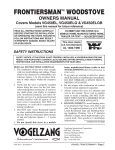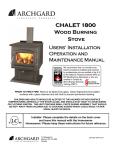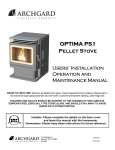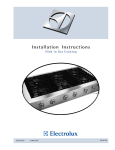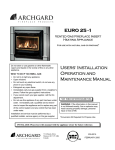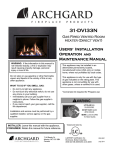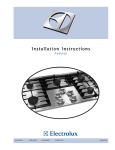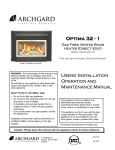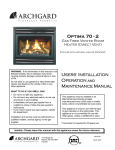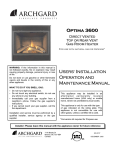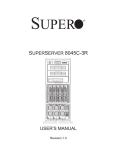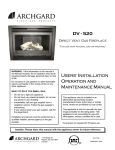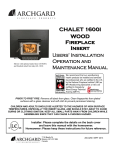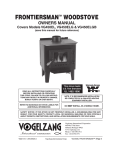Download Archgard CHALET 1800 Specifications
Transcript
CHALET 1800 WOOD Fireplace Insert Users’ Installation Operation and Maintenance Manual PRIOR TO FIRST FIRE: Remove all labels from glass. Clean fingerprints from plated surfaces with a glass cleanser and soft cloth to prevent permanent staining. CHILDREN AND ADULTS SHOULD BE ALERTED TO THE HAZARDS OF HIGH SURFACE TEMPERATURES, ESPECIALLY THE INSERT GLASS, AND SHOULD STAY AWAY TO AVOID BURNS OR CLOTHING IGNITION. KEEP ALL SMALL PARTS AWAY FROM CHILDREN WHILE ASSEMBLING SINCE THEY CAN CAUSE A CHOKING HAZARD. Installer: Please complete the details on the back cover and leave this manual with the homeowner. Homeowner: Please keep these instructions for future reference. 7116 Beatty Dr Mission, BC V2V 6B4 Canada May 2006 200-0241 Chalet 1800 Ins 2 TABLE OF CONTENTS Important Safety Notes 4 Rating Plate Label 5 Clearances 6 Dimensions 7 Specifications 8 COMPONENT INSTALLATION / MAINTENANCE AND OPERATION METHODS Door Installation and Assembling 9 Face Plate Installation and Assembling 10 Blower / Fan Installation 11 Blower Operation & Diagram 12 Brick Removal And Installation 26 Air Tube And Ceramic Baffle Installation and Removal 26-27 Door And Glass Maintenance 28-29 Paint 29 INSERT INFORMATION FOR INSTALLATIONS Venting Requirements 19 Precautions For Installation 13 Installation Methods 14-18 First Fire And Operation of Insert 19-20 TROUBLESHOOTING / SAFETY / CHIMNEY AND WOOD Troubleshooting 20-21 Creosote & Chimney Fires 22-23 Safety Equipment 23 Chimney Maintenance 23 wood Ash Disposal 23-24 25 ACCESSORY / PARTS REPLACEMENT Accessory & Replacement Parts List Archgard Warranty Warranty Registration Card Notes Installation Information 30-31 32 Chalet 1800 Ins 3 ARCHGARD CHALET 1800 WOOD FIREPLACE INSERT Surround Trim, Standard Black (optional Brass or Nickel) Standard Adjustable Faceplate Firebox with Door and Spring Handle Blower Congratulations on choosing a state-of-the-art Archgard Hearth Product! The hand crafted Archgard CHALET 1800 WOOD Fireplace Insert has been designed to provide you with comfort, security and economy for many years of trouble-free enjoyment. It has been our experience that the overall enjoyment of your new appliance will be greatly enhanced by becoming familiar with its installation, operation and maintenance. Prior to installation, we ask that you take a few moments to read this manual. We wish you and your family many years of enjoyment in the warmth and comfort of this hearth appliance. Thank you for choosing Archgard Industries! Chalet 1800 Ins 4 IMPORTANT SAFETY NOTES 1. 2. 3. 4. 5. 6. 7. 8. 9. 10. 11. 12. 13. 14. 15. 16. 17. 18. 19. 20. 21. 22. 23. 24. 25. 26. 27. When installing your insert, particular attention should be paid to fire protection. If this room heater is not properly installed, a house fire may result. To reduce the risk of fire, follow the installation instructions. Contact local building, fire officials or the authority having jurisdiction about restrictions, installation, inspection and permit requirements in your area. CAUTION: Never use gasoline, gasoline-type lantern fuel, kerosene, charcoal lighter fluid, or similar liquids to start or “freshen up” a fire in this heater. Keep all such liquids well away from the heater while it is in use. DO NOT BURN GARBAGE OR FLAMMABLE FLUIDS SUCH AS GASOLINE, NAPHTHA OR ENGINE OIL. Do not burn treated wood, or salt laden (driftwood, etc.) wood. Burning materials other than wood (including charcoal) under adverse conditions may generate carbon monoxide in the home, resulting in illness or possible death. Your insert should burn dry, standard firewood only. The use of cut lumber, plywood, “mill ends”, etc. is not recommended as this fuel can easily overheat your wood insert. Chemically treated fire logs must not be burned in your wood insert. Do not store any fuel closer than 2 feet from your unit. Do not place wood, paper, furniture, drapes or other combustibles near the appliance. During operation, if any part of the insert starts to glow, the insert is in an over-fired condition. Close the air control completely by pushing it in until the glowing has stopped. OVERFIRING VOIDS YOUR WARRANTY and can be hazardous! RISK OF FIRE! Do not operate with insert door open. It can overfire your appliance and could be hazardous WARNING! Never draw outside combustion air from a wall, floor or ceiling cavity or from any enclosed space such as an attic or garage or carport. Check your chimney system thoroughly when installing into an existing masonry chimney. Seek professional advice if in doubt about its condition. Comply with all minimum clearances to combustibles as shown in this manual. Build fire on brick firebox floor. Do not use grates, andirons or other methods to support fuel. HOT WHILE IN OPERATION! Keep children, pets, clothing and furniture away. Contact can cause skin burns. Do not operate without fully assembling all components. Doing so will void your warranty, and could present a serious safety hazard. Solid fuel-burning appliances shall be installed in such a manner as to provide ventilation and combustion air supply to allow for the proper combustion of fuel, chimney draft and the maintenance of safe temperatures. The controls of your unit or the air supply passages should not be altered to increase firing for any reason. If you burn the unit too slowly or at too low a setting your unit will not be operating as efficiently as it can. An easy rule of thumb says that if your glass is clean, then your flue is clean and your exhaust is clean. Burn the insert hot enough to keep your glass clean and you won't need to clean your flue as often. Check you chimney twice a month for creosote accumulation and sweep as required. Burning wet or green, unseasoned wood, could cause excessive creosote accumulation in the flue pipe and chimney. This could result in a chimney fire. Store wood in a dry location. Do not permit creosote or soot build-up in the chimney system. Check and clean chimney at regular intervals. Failure to do so can result in a serious chimney fire. Ashes should be disposed of carefully, using a metal container. Do not connect to any air distribution duct or system. Do not connect this unit to a chimney flue already serving another appliance. This appliance must be connected to a chimney and terminate to the outside of the building envelope. Never vent to another room or inside a building. Do not operate if the gasket on the door is missing or damaged. Use only manufacturers approved parts Do not operate with broken glass. Use only manufacturers approved replacement parts Do not use “Black” or “Galvanized” pipe in your flue system For further information refer to NFPA 211 (USA), CAN/CSA-B365 (Canada) or any other appropriate local codes. LISTED FACTORY BUILT FIREPLACE INSERT CERTIFIED FOR USE IN CANADA AND U.S.A B C XXXXX DO NOT REMOVE THIS SERIAL # 16.25”/412.75 mm Side Wall to Insert= A Top of Insert to Bottom of Mantle (Depth)=B 8.75”/222mm Side of Insert to Mantle Leg=C Canada=18”/450mm USA= 16”/400,\mm Hearth Extension Front=D Canada = 8”/200mm USA = 8”/200mm Hearth Extension Side =E MINIMUM CLEARANCES TO COMBUSTIBLE MATERIALS (MEASURED FROM INSTALL AND USE IN ACCORDANCE WITH THE MANUFACTURER’S INSTALLATION AND OPERATING INSTRUCTIONS. INSTAL AND USE ONLY IN MASONARY FIREPLACE. CONTACT LOCAL BUILDING OR FIRE OFFICIALS ABOUT RESTRICTIONS AND INSTALLATION INSPECTION IN YOUR A E SAFETY LABEL CAUTION 2007 2008 HOT WHILE IN OPERATION. DO NOT TOUCH. KEEP CHILDREN, CLOTHING AND FURNITURE AWAY. CONTACT MAY 2006 JAN FEB MAR APR MAY JUN JUL AUG SEPT OCT NOV DEC This unit has been approved for use in Washington State ,USA. 6” = 26”/660mm 8” = 28”/711mm 12” = 32”/813mm These installation instructions describe the installation and operation of the Archgard CHALET 1800 WOOD Fireplace Insert. This insert meets the U.S. Environmental Protection Agency’s 1990 particulate emission standards. It is also listed by Warnock Hersey Test Laboratories, Inc. to UL Safety Standard 1482 and ULC S628. It also meets the requirements of (UM) 84-HUD. UNITED STATES ENVIRONMENTAL PROTECTION AGENCYCERTIFIED TO COMPLY WITH JULY 1999, PARTICULATE EMMISSIONS STANDARDS. NOTE: Archgard units are constantly being improved. If there is a conflict between the label on the unit and the one printed here, the label on the unit is the correct one. The safety label is attached to the side of the unit. INSTALL ONLY ON A NON-COMBUSTIBLE HEARTH, COMBUSTIBLE FLOOR MUST BE PROTECTED BY NON-COMBUSTIBLE WHEN LOCATING YOUR INSERT: Consider safety and the fact that the insert will need a chimney. It is a good idea to plan your installation on paper, using exact measurements for clearances and floor protection before actually beginning the installation. 303-0144 A copy of the label that accompanies each Archgard Chalet 1800 WOOD Fireplace Insert , is printed here for your convenience. D SAFETY NOTE: If this insert is not properly installed, a house fire may result. For your safety, follow the installation instructions. Contact your local building or fire officials, or any other authority having jurisdiction about restrictions and permit/inspection requirements in your area. .COMPONENTS REQUIRED FOR INSTALLATION: FAN KIT(FK-1800INS) ELECTRICAL RATING: 1AMP, 60Hz, 120VOLTS 6 “/150MM STAINLESS STEEL LINER. DANGER, RISK OF ELECTRIC SHOCK, DISCONNECT POWER BEFORE SERVICING UNIT. DO NOT ROUTE POWER CORD UNDER OR INFRONT OF APPLIANCE. DO NOT REMOVE BRICKS OR MORTOR IN MASONARY FIREPLACE. FOR USE WITH SOLID FUEL ONLY. DO NOT USE GRATE OR ELEVATE FIRE. BUILD WOOD DIRECLT ON HEARTH. RISK OF SMOKE AND FLAME SPILLAGE, OPERATE ONLY WITH DOORS CLOSED, OPEN DOOR TO FEED FIRE ONLY. REPLACE GLASS WITH 5MM CERAMIC ONLY. INSPECT AND CLEAN CHIMNEY FREQUENTLY. UNDER CERTAIN CONDTIONS OF USE CREOSOTE BUILD UP MAY OCCUR RAPIDLY. DO NOT OVERFIRE, IF INSERT GLOWS, YOU ARE OVERFIRING. YOUNG CHILDREN SHOULD BE CAREFULLY SUPERVISED WHEN THEY ARE IN THE SAME ROOM AS THE APPLIANCE. 5 Chalet 1800 Ins Chalet 1800 Ins 6 Minimum Fireplace Size Your fireplace opening requires the following minimum sizes: Height Width Depth From back of adjustable faceplate to front of flue collar 22” (559mm) 25” (635mm) 16” (406mm) 6” to 9”(152mm to 229mm) Insert Clearances to Combustibles Side Wall to Insert Top of Insert to Side of Insert to Hearth Extension Hearth Extension = Bottom of Mantle Mantle Leg = C - Front = D - Side = E A (Depth)F = B 16.25""/412.75mm 6” = 26"/660mm 8” = 28”/711mm 12” = 32”/813mm 8.75""/222mm Canada = 18"/450mm USA = 16”/400mm Canada = 8"/200mm USA = 8”/200mm F = (mantle depth) B C A D E Hearth Protection In the USA, the floor pad (ember protection) must be of non-combustible material and must extend 16" in front of the door opening and 8" to the sides and rear of the unit. Consult with your local inspector/authority having jurisdiction or check the NFPA 211 or local codes. In Canada, the floor pad (ember protection) must be of non-combustible material and must extend 18" (450mm) in front of the door opening and 8" (200mm) to the sides of the unit. A 0.38 mm (0.015 in) thick metal sheet or a grouted ceramic floor-tile surface installed in accordance with recognized Building Codes shall be considered a durable pad. A floor pad shall not be placed on top of a carpet unless the pad is structurally supported to prevent displacement and distortion. Consult with your local inspector or check the CSA B365. All floor protection must be non-combustible (i.e., metals, brick, stone, mineral fiber boards, etc.). Any organic materials (i.e., plastics, wood paper products, etc.) are combustible and must not be used. Chalet 1800 Ins 7 40” (1016 mm) 46” (1168 mm) Optional DIMENSIONS 24” (609 mm) 28” (711mm) 32” (813 mm) Optional 21.75” (553 mm) 25.25”(641 mm) Adjustable 9”- 12”(229– 305 mm) 6.125” (154 mm) 6” ID (152.4 mm) 28” (711 mm) 21.75” (553 mm) 27.875 “(708 mm) 24” (610 mm) 6” ID Adjustable 9” - 12” (229 - 305 mm) 27.875 “(708 mm) 20” (508 mm ) 40” (1016 mm) Chalet 1800 Ins 8 SPECIFICATIONS MODEL CHALET 1800 WOOD FIREPLACE INSERT HEIGHT OF BODY 21.75” (553 mm) WIDTH of BODY 24” (609.6 mm) DEPTH of BODY 25.250” (641 mm) E.P.A. EMISSIONS E.P.A. OUTPUT RATING APPROXIMATE HEATING AREA DURATION ON LOW FIRE INSERT BODY WEIGHT WITH PACKAGING 3.6 grams / hour 10,700 - 35,500 BTU / HR (3,134 - 10,397 watt) 800 - 1,500 FEET2 (74.3 - 139.4 METRE2) 6 - 10 HOURS 310 lb (140.61 kg) Surround Panels Standard (width x height) 40"W x 28"H (1016mm x 711mm) Optional (width x height) 46"W x 32"H (1168mm x 813mm) Chalet 1800 Ins 9 DOOR ASSEMBLY & INSTALLATION The door comes assembled with the glass and gasket. 1. Run the threaded end of the handle through the hole in the cast door. Roller 2. Insert the clevis pin into the roller Clevis Pin 3. Insert the end of the clevis pin and roller assembly into the hole in the end of the handle Cotter Pin Bolt & Lock Nut 4. Insert the cotter pin into the end of the clevis pin to keep the assembly from coming apart. Cotter pin goes through Clevis pin as shown here 5. Attach spring handle by rotating the spring counter clockwise onto the rod. Ensure that the spring screws onto the rod at least ½”. 6. After the handle is assembled, close the door and see how the door closes. If it is too tight, turn the handle clockwise to loosen it. If it is too loose, turn the handle counter clockwise to bring the door closer to the insert body. 7. To verify that the doors are well sealed, insert a piece of paper between the door and the insert body. You shouldn’t be able to pull the paper out. Tighten it to the point where the paper is starting to tear when you are pulling it out. 8. At this point take the lock nut and thread it onto the lock bolt and thread the assembly into the hole provided just under the door handle assembly and lock down the lock nut. This is to keep the handle from turning. 9. Cover the holes with the two decorative plug buttons Chalet 1800 Ins 10 Faceplate Installation NOTE: There is 6” to 9” of adjustability between the back of the faceplate and the front of the flue collar. The faceplate box will have all required hardware for installation. 1) Start the installation by remounting the 4 angle clips into the predrilled holes in the top and bottom of each side of the insert as shown. The faceplate will mount flush with the surface it is covering. Take this into account when adjusting the 4 mounting brackets. 2) Remove the Faceplate and Louver assembly from the packaging. From the back, screw the louvered section to the top section of the faceplate as shown with 3 self tap screws. (complete surround not shown) BRACKETS Start by placing some form of protection on top of the insert top so that the surface will not be scratched as you slide the faceplate and louvered section onto the top. The bottom left leg of the faceplate has a notch that will slide over the air adjustment rod as shown below. Push the faceplate back until it contacts the 4 installed brackets. Make sure that the faceplate is flush and even with the area it is covering. Adjust the brackets as required. Remove the material used as protection and using 4 black supplied screws install the faceplate to the brackets. Left and right side as shown. The faceplate will slide past the rod. Install the small coil handle supplied with the door assembly onto the shaft Chalet 1800 Ins 11 BLOWER / FAN ASSEMBLY AND REMOVAL. (MODULE COMES PACKED IN FIREBOX ) The CHALET 1800 WOOD Fireplace Insert is certified for operation with or without the fan. CAUTION: Do not plug in Fan Module until full Insert installation has been completed. If servicing is required or if you need parts contact your dealer or installer. To install or remove the fan module follow these steps. 1. There are four screws used on fan mounting brackets left and right ,as shown below Remove the 2 screws on the side of the bracket. 2. Install the sensor bracket as shown with the 2 screws as shown below. If parts or servicing is required please consult a professional to avoid injury. If the wires have been removed from the sensor re-install them by matching the two female spade connector leads to the two male tabs on the heat sensor as shown. 3. Slide the fan module into place making sure that wires cords are not caught or pinched into the fan or housing .Align the holes in the fan housing and insert brackets and install screws. Call your dealer if you require assistance. Caution: The connection cord should not be routed under or in front of the assembly and also kept away from any hot surfaces. Do not route cord under or in front of unit. Electrical Rating = 120V AC / 1.0 amps 60hz Fan Output Rating = 150 c.f.m. Chalet 1800 Ins 12 FAN OPERATION Automatic To operate the fan automatically, push the top switch on the side of the fan housing to "AUTO" and the bottom switch to either "HIGH" or "LOW" for fan speed. This will allow the fan to turn on as the stove comes up to operating temperature. It will also shut the fan system off after the fire has gone out and the unit cools to below a useful heat output range. Manual To manually operate the fan system, push the top switch to "MAN" and the bottom switch to either "HIGH" or "LOW". This will bypass the sensing device and allow full control of the fan. Switching from "AUTO" to "MAN" or "HIGH" to "LOW" may be done anytime. CAUTION: Label all wires prior to disconnection when servicing controls. Wiring errors can cause improper and dangerous operation. WARNING: Electrical Grounding Instructions This appliance is equipped with a three-pronged (grounding) plug for your protection against shock hazard and should be plugged directly into a properly grounded three-prong receptacle. Do not cut or remove the grounding prong from this plug. The CHALET 1800 WOOD Fireplace Insert must be electrically grounded in accordance with local codes or, in the absence of local codes, with the National Electrical Code, ANSI/NFPA 70, or the Canadian Electrical code, CSA C22.1. FAN WIRING 120 Chalet 1800 Ins 13 BEFORE INSTALLING AND USING THIS APPLIANCE. The installation of Smoke and Carbon Monoxide detectors along with a minimum of a five pound fire extinguisher is highly recommended in any home . When you first fire up your CHALET 1800 WOOD Fireplace Insert, you may notice the smoke detectors operating more frequently. This may be due to the curing of stove paint or oils from manufacturing or fumes caused by accidentally leaving the door open. Do not disconnect the detectors. Consult local building or fire officials about restrictions and installation inspection and permit requirements in your area. Let your home insurance company know that you plan to install this CHALET 1800 WOOD Fireplace Insert in your home. Please read this entire manual before you install and use this CHALET 1800 WOOD Fireplace Insert in your home. Failure to follow instructions may result in property damage, bodily injury or even death. Install and use only in accordance with manufacturer’s installation and operating instructions. Have the chimney & fireplace inspected and swept prior to installing the CHALET 1800 WOOD Fireplace Insert to be sure that the chimney/fireplace meets local requirements for construction and clearances for Chimneys and Fireplaces and/or N.F.P.A. 211 Standards in the USA and Provincial Building codes and CSA B365 - Installation Code for Solid Fuel Appliances in Canada or any other applicable local code requirements and is OK to have an insert installed into it and also ensure that the flue is free of creosote. Do not connect the insert to a chimney system servicing another appliance The chimney damper may be removed to install the chimney liner. Check local codes first If using a Direct Connect, a means must be provided for removal of the insert to clean the chimney flue. If using a Direct Connect, a clean-out door may be required, by your Authority having Jurisdiction A permanent metal warning label must be attached to the back of the fireplace stating that the fireplace may have be altered and may be unsafe to use without the insert. Do not use unlabelled parts, or substitute parts made for another chimney system . Install only to liner/chimney manufacturer's installation instructions. The chimney must be suitable for wood burning use. Check for creosote build up or other obstructions. Inspect your chimney for cracks, loose mortar or other physical defects, if any are found, use the full liner method of installation, do not use the blocker plate or Direct Connect method. RECOMMENDED MINIMUM CHIMNEY HEIGHTS The chimney must be at least 3 ft. (.9m) higher than the highest point where it passes through the roof and at least 2 ft. (.6m) higher than the highest part of the roof or structure within 10 ft. (3m) of the chimney, measured horizontally. These are code requirements and cannot guarantee a suitable draft. We recommend using a minimum total system height of 12 ft. (3.6m), measured from the flue collar to the bottom of the chimney cap) Chalet 1800 Ins 14 INSTALLATION INTO A MASONRY CHIMNEY In the USA, there are two ways that this insert can be installed into a masonry fireplace. One is with a full Stainless Steel Liner or Positive Flue Connection or the second method, which is called the Direct Connection or the connection from the flue collar of the insert to the first flue tile in the chimney. We at Archgard recommend the Full Liner installation for numerous reasons. The CHALET 1800 WOOD Fireplace Insert is designed with a 6" flue collar and by installing a full liner from the top of the flue collar of the insert all the way to the top of the chimney optimizes draft conditions and performance and it eliminates the need to pull the insert out of the fireplace every time you need to have the chimney swept. You will find that if you are doing the full reline, you may also have to insulate the liner to manufacturers installation instructions. The benefit to insulating the liner is that it stays hotter, therefore you will get a better draft and less condensation which means less creosote which means a safer better performing system. The other installation option is the Direct Connection. In this method, a blocker plate is installed in the throat area of the fireplace with a hole, the diameter of the flue pipe, cut out in the area above the flue of the insert. This blocker plate is installed and a stainless pipe (stainless steel because it is in a concealed space - do not use black or galvanized pipe) installed through the hole and up to the first flue tile. The insert is installed into the firebox and the flue pipe is hooked up to it and the assembly is sealed. If it’s an inside chimney and the flue cross-sectional area is more than three times the crosssectional area of the flue collar on the insert or if it’s an outside chimney, meaning if it has at least one side exposed to the weather, and it’s cross-sectional area is more than two times that of the flue collar of the insert, then, according to NFPA 211, you cannot install the insert with the Direct Connect method. You must install a full liner. The cross sectional area of the 6” flue collar is 26 square inches. Once you start venting this appliance into an oversize flue, the exhaust gases start slowing down and so does the draft. Once the draft slows down, the by-products of combustion have more time to give off their heat to the chimney walls and reduce the draft even more, this is called “residence time” and at the same time depositing tar droplets on the chimney walls as creosote. The optimum rule of venting is to have flue gas temperature in the vent system above dew point (in a vapor) so that the exhaust exits the top of your chimney before it turns from a vapor state to a moisture state and condenses on the chimney walls forming acids and creosote. If the flue is oversized, install a full liner Chalet 1800 Ins 15 FULL LINER INSTALLATION There are different ways of installing a full liner, you can drop it in from the top or bring it up from the bottom. In the USA, in order to meet the requirements of UL 1777, you may have to insulate your liner and if you do, it will have to be done as a system to manufacturers certified installation instructions. In Canada, you can run ULC S635 or ULC S640 liner systems. If you would like to obtain a system with certified reduced clearances, there are manufacturers who have tested their ULC S640 liners for close clearance and even zero clearance to combustibles using their own insulation/ installation requirements which must be adhered to. As Archgard has no control over what liner system is being used with the CHALET 1800 WOOD Fireplace Insert, here we can only give a general overview of the installation procedure of dropping a generic uninsulated liner from the top of the chimney and connecting it to the flue collar of the appliance. It is of the utmost importance that the installation instructions of the liner system that you will be using be consulted when doing your installation. 1. If you will be doing any modifications to the damper assembly or to the back wall or smoke shelf (first check if you are allowed to do so), to accommodate the liner, now would be a good time to so and to fasten the permanent warning label, that comes with the insert, to the back wall of the fireplace warning future owners that the fireplace may have been altered to do this installation, in the event that the insert is ever removed. 2. Drop the liner down from the top of the chimney. If it is a tight fit or if offsets are present, you may have to attach a cone to the end of the liner with some rope coming out the end of it or just squeezing the ends of the liner together and duct taping some rope to the end it. Drop the rope down and with someone at the bottom pulling on the rope and someone at the top pushing on the liner, it should get to the bottom. 3. When it gets past the smoke shelf (you may have problems getting the liner past this point, you may have to order an ovalized liner or you may wish to ovalize a section of liner yourself. If you ovalize it yourself, check with the liner manufacturer to see if they will honor any warrantees if you ovalize the liner. If you aren’t careful or don’t have the equipment, you could damage the liner when you ovalize it), if you squeezed the ends of the liner, cut the damaged ends off with a knife and tin snips. If an adapter is being used, rivet it onto the flex liner now. Rivets work better on thin liner because screws tend to work their way out (loosen out) but if you use rivets, make sure you use rivets that are marked SSSS for Stainless Steel Shank and Stainless Steel Rivet. If you use rivets that just say SS then all you are getting is a Steel Shank and Steel Rivet and they will corrode in a short time. NOTE: a) masonry or steel shall not be removed from the fireplace to accommodate the appliance; (b) masonry or steel, including the damper plate, may be removed from the smoke shelf and adjacent damper frame if necessary to accommodate a flue liner, provided that their removal will not weaken the structure of the fireplace and chimney and will not reduce protection to combustible materials. Chalet 1800 Ins 16 4. If you are using a 6” outside dimension Stainless Steel liner (since this is a concealed area do not use “black” or “galvanized” pipe), the liner will slip right into the flue collar and can be attached into the three pre-punched flue collar holes or the two supplied angle brackets and the front flue collar hole may be used. NOTE: In some cases you may need to use some rigid components like elbows or a transition box to make the connection from the liner to the insert (contact venting component supplier for availability and information). Or you may have to use an ovalized section of liner or remove some brick from the back wall of the smoke shelf. Please check with the Authority having Jurisdiction before using some of these components or doing this type of work to make sure this is compliant in your area. 5. If the firebox floor is “dropped”, screw in the supplied leveling bolts before installing the insert. Put a level from the top of the hearth to the back of the firebox and measure how high the drop is, in the area at the back of the firebox where the insert leveling bolts are. Push the insert into position in the fireplace opening. When you start sliding the insert back over the drop floor, reach under the insert and start to unscrew the leveling legs to the height that is needed to make the insert sit level when it is in it’s final FLEX TO RIGID ADAPTOR resting place. Leveling Bolts 6. If the fireplace opening is high enough for you to get into the top of the insert, then you can reach in and get the liner and fit it into the flue collar and mechanically attach it. If the room is not there, then install the optional flex to rigid adaptor on the end of the liner, slip in the cross bar and screw on the two nuts according to manufacturers instructions, and finish the liner to the same height as the finished insert height and push it up out of the way before installing the insert 7. Remove the Secondary Air Tubes and Baffle Plates from the insert. After installing the insert into the firebox reach in through the flue collar and grab the cross bar on the liner adapter and pull down. 8. Take the “hook” piece out of the kit and hook it over the cross bar and then take the longer crossbar with the nut in the middle and put the hook through the nut and tighten that assembly to the bottom of the insert. 10. Go back to the top of the chimney and seal off the top of the chimney and liner with the manufacturers terminations. NOTE: More reasons for insulating the liner and sealing it at the top is that it will stop down drafts when the appliance is not operating and keeps room air from entering the chimney cavity. When it is raining on the metal flashing or raincap, the insulation deadens the sound. The insulation stops condensation from forming on the bottom of the metal flashing and dripping down the chimney and sometimes right on top of the insert. 12. Back inside, if necessary, reinstall the bricks, secondary air tubes and ceramic baffle plates. 13. Finish by installing the faceplate/trim and door and the optional blower if ordered. Chalet 1800 Ins 17 INSTALLATION INTO A MASONRY CHIMNEY WITH A DIRECT CONNECT Check with you local Authority having Jurisdiction before you begin you begin an installation of a Direct Connect System to ensure compliance with local codes, including the need for permits and follow-up inspections. If required, always obtain a building permit so that insurance protection benefits cannot be unexpectedly cancelled. Contact your local dealer if any assistance is required during installation. NOTE: In some areas, you may be required to install a clean out/inspection door on the backside of your chimney, just above the smoke shelf area. A means must be provided for removal of the insert to clean the chimney flue. Check with your local Authority Having Jurisdiction for more information about requirements in your area. 1. If you are going to remove the damper and frame, install a clean out door and fasten the permanent warning label, that comes with the insert, to the back wall of the fireplace warning future owners that the fireplace may have been altered to do this installation, in the event that the insert is ever removed, now would be a good time to do it. If you will be securing the damper in the open position, do it now. 2. Once these are done, carry on with the preparation of the Blocker plate Back wall of fireplace Blocker Plate Bend flanges at dotted lines Front of fireplace 2. You will need some sheet metal, at least 24 guage in thickness, two inches larger all around than the throat area of the fireplace. Depending on the fit, you will need some flat gasketing, some masonry anchors and some stainless steel liner to go from the top of the flue collar of the insert to the first flue tile in the chimney. 3. With a piece of soapstone or chalk, mark a line, using a level, just below the damper on the backside, sides and front in the throat area of the fireplace. Installing the blocker plate horizontally will make it much easier to cut the hole for the liner to go through. It’s easier to cut a tight round hole than a tight oval hole. NOTE: a) masonry or steel shall not be removed from the fireplace to accommodate the appliance; (b) masonry or steel, including the damper plate, may be removed from the smoke shelf and adjacent damper frame if necessary to accommodate a flue liner, provided that their removal will not weaken the structure of the fireplace and chimney and will not reduce protection to combustible materials. 4. Layout the measurements onto the sheet metal leaving an two inches all the way around for a flange (do not measure exactly mark your measurements short, the gasket will take up the gap) 5. Cut out your marks and notch the four corners so that you can bend the flanges down and then you can insert your fasteners into them. Because you measured short, do not bend the flanges over at a 90o angle but closer to 60 o Drill the holes for your anchors 7. Test the fit by pushing the blocker plate into the throat of the fireplace. Now determine where the hole for the liner will go in the plate either by measuring or by pushing the insert into position and marking the hole location. Mark your anchor hole locations at the same time Chalet 1800 Ins 18 8. Drill the anchor holes in the firebox 9. Cut the hole in the sheet metal. An easy way is to put the sheet metal over a block of wood and hammering into the centre of where the hole will be with the claw of your hammer and then cutting the resulting gash out with tin snips. 10. Using some adhesive gasketing material, tape the gasket around the flanges of the blocker plate and then push it into position in the fireplace and anchor it. 11. Slide the Stainless Steel liner (since this is a concealed area do not use “black” or “galvanized” pipe) in through the hole and slide the insert into position and attach the liner into the flue collar and seal the hole in the blocker plate with some rope gasket. You could cut the hole for the liner a little large and then using some rope gasket, a little larger in circumference than the hole, cut through it and slip it all around the edge of the cut hole and screw it into the blocker plate in a few places so that when you slip the liner through, it will make a good seal or you could just take the gasket and screw it around the hole in the blocker plate so that when the liner goes through the hole, it will make for a good tight fit and will be the seal between the liner and blocker plate. 12. If you are using a 6” outside dimension liner, the liner will slip right into the flue collar and will be attached by the three pre-punched flue collar holes or the two supplied angle brackets and the front flue collar hole may be used. If the optional flex to rigid adaptor is being used(using something like this makes installation much easier if you have to install through the appliance), slip in the cross bar and screw on the two nuts (following the manufacturers instructions). 13. Push the liner up so that will be ready to pull down into the insert flue collar. 14. If the firebox floor is “dropped”, put a level from the top of the hearth to the back of the firebox and measure how high the drop is towards the back of the firebox in the area where the insert leveling legs will be. Push the insert into position in the fireplace opening. When you start sliding the insert back over the drop floor, reach under the insert and start to unscrew the leveling legs to the height that is needed to make the insert sit level when it is in it’s final resting place. 15. If the fireplace opening is high enough for you to get into the top of the insert, then you can reach in and get the liner and fit it into the flue collar and mechanically attach it. If the room is not there, then reach in through the inside of the inFLEX TO RIGID ADAPTOR sert by removing the air tubes and baffle plates and then reaching up through the flue collar and grabbing the cross bar on the liner and pulling it down. Take the “hook” piece out of the kit and hook it over the cross bar and then take the longer crossbar with the nut in the middle and put the hook through the nut and tighten that assembly to the bottom of the insert (contact venting component supplier for availability and information). Optional Cleanout First Flue Tile SS Liner Blocker Plate 16. If necessary, reinstall the bricks, secondary air tubes and ceramic baffle plates. 17. Finish by installing the faceplate/trim and door and the blower if it was removed for installation of the insert. BLOCKER PLATE INSTALLATION Chalet 1800 Ins 19 VENT SPECIFICATIONS Your CHALET 1800 WOOD Fireplace Insert was designed for and tested on a 6” (152mm) chimney, 15’ (4.57m) high, (includes insert height) measured from the base of the insert. The further your stack height or diameter varies from this configuration, the greater the possibility of performance problems. In addition, exterior conditions such as roof line, surrounding trees, prevailing winds and nearby hills can influence insert performance. Your local dealer is the expert in your geographic area and can usually make suggestions or discover solutions that will correct any flue problem you may have, allowing your wood insert and its flue system to operate correctly and provide safe and economical heat for your home. Pull this control all the way out when first starting the insert. Once the fire has been established you may adjust this control to set the burn rate of the fire. If this damper is closed at first start-up, the fire will burn very slowly and could soot the appliance. OPERATION 2. Crumple four or five sheets of newspaper and put them on the firebox in the centre of the heater (never use a grate or build the fire off the floor of the insert)– be generous and you will have more success. Hold the paper down with 10 to 15 pieces of dry kindling. Softwoods, such as cedar and pine, make good kindling (use the species available in your region). Air quality is important to all of us, and if we choose to use wood to heat our homes, we should do so responsibly. To do this, we need to learn to burn our inserts in the cleanest way possible. Doing this will allow us to continue using our wood inserts for many years to come. AIR CONTROL - PRIMARY AIR SYSTEM (DRAFT CONTROL) When shutting down the insert, fully open the air control. This allows the chimney temperatures to remain as high as possible for as long as possible. Cold chimney temperatures create creosote. FIRST FIRE 1. The first step in building a fire is to open the air control. Place the kindling on and behind the newspaper, so that the combustion air reaches the newspaper first where you light it. It is also a good idea to add one or two small pieces of dry firewood to the kindling load before lighting. The primary air enters at the base of the firebox and travels through passages toward the upper front of the 3. Light the newspaper and close (but don’t latch) the door. When the paper is flaming brightly and the firebox, near the top of the glass door. This preheated kindling catches and the chimney is producing air supplies the necessary fresh oxygen to mix with the strong draft, latch the door. CAUTION: Never leave unburned gases, helping to create secondary combusthe unit unattended if door is left open. This protions. This air is regulated by the Primary Control at cedure is for start-up only, as the unit may the bottom left side of the appliance. For more primary over-heat if the door is left open for too long. air, pull the control out. For less air, push the control in. 4. When the flames from the kindling load begin to subside, gradually add several small pieces of wood. Avoid smothering the fire with the new wood. Place the pieces on and behind the burning kindling. Wood should be flaming until it is reduced to charcoal. Never let a fire smoulder because smouldering wastes wood. For the first few hours, the insert will give off an odor from the paint. You may want to leave some windows and/or doors open to provide adequate ventilation while this temporary condition exists. In some instances, your smoke detector may alarm. Do not build hot fires in your insert for the first few days until the paint has had a chance to cure with some moderate fires. Chalet 1800 Ins 20 5. Before opening your door to reload, open the draft fully for approximately 10 to 15 seconds until the fire has been reestablished. This will minimize any smoking. All fuel burning appliances consume oxygen during operation. It is important that you supply a source of fresh air to your unit while burning. Ignore the fire until you notice the room, space or house cooling off. A new load cools the firebox, so it needs to be heated up again. Then add the right amount of wood to suit the conditions. Wood burns best in cycles. A cycle starts when wood is placed on and behind a raked coal bed. A cycle ends when the load is reduced to the same sized coal bed. Do not force wood into the firebox to try and fill it. We recommend that when you first fire up your CHALET 1800 WOOD Fireplace Insert, you leave a door and/or window open in order to vent the smoke that may be created from the unit’s paint curing. The paint will smell a little for the first burn or two as it cures. TROUBLESHOOTING The most common factors for poor draft are: a) Air supply/House depressurization b) Environmental conditions c) Cold chimneys d) Poor chimney/connector installation/ design and maintenance a) Air supply / House depressurization – Inside the home, household appliances such as clothes dryers, bathroom fan, central vacuums, forced-air furnaces, etc, compete for air, resulting in air starvation to the fire. This creates a condition known as negative pressure. When a negative pressure situation is experienced, the combustion gases can be drawn from the chimney and into the house. This condition is commonly referred to as down-drafting. Increased amounts of insulation, vinyl windows and extra caulking in various places can all keep heat in but may also make a home more airtight. Seal the leaks that are high in the house because the house acts as a chimney and as hot air leaves the house at the ceiling level, more air comes in at lower levels to make up for the air that leaves. Make sure there is adequate air for the appliance in the house. b) Environmental Conditions - High trees, low-lying house location such as in a valley, tall buildings or structures surrounding your house and windy conditions can cause poor draft. c) Cold Chimney Temperature - Avoid cold chimney temperatures by burning a hot fire for the first fifteen to forty minutes, being careful not to over-fire the insert. Where possible, install a thermometer on or in the flue pipe so temperatures can be monitored. d) Chimney Installation and Maintenance - Avoid using too many elbows or long horizontal runs. Too short a chimney can cause difficult start-up, dirty glass, smoking when door is open, and even reduced heat output. Too tall a chimney may prompt excessive draft, which can result in very short burn times and excessive heat output. If in doubt, contact a chimney expert and/or chimney manufacturer for help. Clean chimney, rain caps and especially the spark arrestor regularly, to prevent creosote build-up, which will significantly reduce chimney draw. Chalet 1800 Ins 21 TROUBLESHOOTING PROBLEM Glass is Dirty CAUSE CURE 1. Wood is wet Use dry wood 2. Turning down air control or damper too soon Do not turn down until: ❖ there is a good bed of coals ❖ the wood is charred 3. Draft too low – Improper chimney height and / or diameter ❖ 4. Door gasket leakage ❖ Chimney plugged or restricted, check flue ❖ Provide outside air for combustion Replace gasket ❖ Check latch 5. Excessive Creosote Buildup See 1,2,3, above Low Heat Output Will not burn Overnight Cannot establish proper burn 1. Wood is wet Use dry wood 2. Fire too small Build a larger fire 3. Draft too low Chimney plugged or restricted, inspect and clean 1. Air control is set too high Set control lower 2. Not enough wood Un-split wood is preferred for overnight burns 3. Draft too high Excessive chimney height or small diameter 1. Combustion air supply blocked ❖ 2. Draft too low ❖ Ensure adequate air is available for combustion Chimney liner plugged or restricted, inspect and clean ❖ Chimney liner oversized or otherwise unsuitable Chalet 1800 Ins 22 CREOSOTE AND CHIMNEY FIRES When wood burns slowly - as it often does in a conventional, air-tight insert or furnace - it makes a smoky fire and produces more creosote deposits than a quick, hot fire does. Creosote is a highly flammable material. If it ignites near the base of the chimney, it can produce a raging fire that travels up the chimney, creating extremely high temperatures as it spreads. The high temperature can damage the clay liners in a masonry chimney or the metal liner in a factory-built chimney. Although 650°C/2100oF chimneys can withstand these temperatures, the heat causes extreme stress in the chimney. Chimney fires result from poor firing techniques combined with a lack of maintenance. If unseasoned wood (wood that hasn't been dried enough) is burned slowly in an old "airtight" heater, creosote can build up quickly and the risk of a chimney fire increases. When you operate wood-burning appliances properly, some creosote may still be deposited, but it will be less combustible. Instead of the black, tarry, highly flammable creosote from smoldering fires, proper firing may create small amounts of soft, flaky and dark brown deposits. You can prevent chimney fires. Have your chimney checked for creosote deposits regularly, until you find out how quickly it builds up in the system. Conventional wood heaters can produce creosote quickly because they can't burn the wood as completely as advanced combustion designs. In severe cases of smoldering, it may take only a few days for enough creosote to build up to sustain a chimney fire. The new, low-emission wood inserts, like the ARCHGARD CHALET 1800 Wood Fireplace Insert burn the wood so completely that, when operated properly, their chimneys normally need cleaning only once a year. Never assume that the chimney is clean. Check it regularly to be sure, especially during the spring and fall. If you do have a chimney fire, have the chimney inspected and repaired, if necessary, before using the system again. A chimney fire is a clear sign of a problem with the appliance, the fuel or the way the system is operated. Make changes to avoid chimney fires in the future. Using an energy-efficient wood-burning appliance, like the Archgard CHALET 1800 Wood Fireplace Insert , coupled with good installation and proper burning techniques, dramatically lowers the chance of a chimney fire. AVOIDING A CHIMNEY FIRE There are two ways to avoid chimney fires: 1. Do not let creosote build up to a point where a chimney fire is possible. 2. Do not have fires in the insert that may ignite chimney fires. These are hot fires, such as when burning household trash, cardboard, Christmas tree limbs, etc. Remember, the Archgard CHALET 1800 WOOD Fireplace Insert , is not a garbage burner. FAILURE TO INSPECT AND CLEAN YOUR CHIMNEY SYSTEM REGULARLY CAN RESULT IN A CHIMNEY FIRE, WHICH COULD DAMAGE THE CHIMNEY OR CAUSE A HOUSE FIRE. Chalet 1800 Ins 23 IN CASE OF A CHIMNEY FIRE 1. Prepare to evacuate to ensure everyone's safety. Have a well understood plan of action for evacuation. Have a place outside where everyone is to meet. 2. Close the air inlet on the insert. 3. Call local fire department. Have a fire extinguisher handy. Contact your local municipal or provincial fire authority for further information on how to handle a chimney fire. It is most important that you have a clearly understood plan on how to handle a chimney fire. 4. After the chimney fire is out, the chimney must be cleaned and checked for stress and cracks before starting another fire. Also check combustibles around the chimney and the roof. The services of a competent or certified installer, (certified by the Wood Energy Technical Training program (WETT) – in Canada, National Fireplace Institute (NFI) - in U.S.A.) are strongly recommended. SAFETY EQUIPMENT All homes with a fuel burning appliance should have at least one fire extinguisher in a central location known to all in the household along with a smoke detection device installed to the smoke detector manufacturer’s placement and installation instructions, and maintained on a regular basis. We also recommend all dwellings be equipped with a Carbon Monoxide Detector and have a practiced evacuation plan. CHIMNEY MAINTENANCE It is very important to carefully maintain your Chalet 1800 insert, including burning seasoned wood and maintaining a clean insert and chimney system. Have the chimney cleaned before the burning season and as necessary during the season, as creosote deposits may build up rapidly. Moving parts of your insert require no lubrication. Have the chimney system cleaned when a significant layer of creosote has accumulated (3 mm / ⅛" or more). At the end of the heating season, have the chimney/insert system inspected and if necessary cleaned/maintained. As a precaution, the chimney should be inspected at least once every month during the heating season to determine if creosote or soot has built up. Check spark arrestor screens at least every 2 to 4 weeks. If creosote or soot has accumulated, it should be cleaned or replaced to reduce the risk of chimney fire. Proper burning will leave the firebricks in the firebox a tan color, never black. Steel parts in the firebox will be light to dark brown, never black or shiny. WOOD The efficiency and convenience of your wood-heating system depend significantly on the quality of the fuel wood you burn. The four main factors that influence how firewood burns are piece size, wood condition, tree species and moisture content. The moisture content of the wood affects the rate at which it burns and the efficiency of combustion. The wood moisture content of unseasoned wood, can range between 35 and 60 percent by weight. Wood that is this wet is hard to ignite and slow to burn. It also hisses and sizzles in the firebox. It combusts poorly and produces large amounts of air pollutants. Energy from the burning fire is used to boil off the moisture, which reduces efficiency. Wet wood is the most common problem with wood heating. If you think you have a problem with your insert's performance, check the dryness of your fuel first. Properly seasoned wood ignites readily, flames easily and burns efficiently. Chalet 1800 Ins 24 WOOD (cont’d) The size of the firewood pieces affects the rate of combustion. Large pieces ignite and release their energy slower than small pieces. Smaller, more finely split pieces are better for short, hot fires, while larger pieces suit extended firing cycles. The largest piece of wood for your Chalet 1800 should be no more than about 15 cm (6 in.) across and 18” long. Another factor that affects how firewood burns is the wood's condition. Wood that has been lying on the ground or has been cut too long ago and starting to rot, will be difficult to burn. Store two or three days' supply of wood indoors, making sure that it is clean and dry. In winter, when you bring wood directly in from the cold outdoors and immediately load it into the appliance, it may initially cool the fire and prevent proper combustion. Remember, storing wet wood indoors could create mould inside the house, so you should limit the amount of wood that you store inside. Several tree species are used for firewood, and those you choose will affect your wood-burning system. The energy content of wood per dry kilogram (i.e., per unit of weight) is similar regardless of species (approximately 8,600 BTU/lb at 15% moisture content). However, the energy output from each piece of wood (weight per unit volume) of various species differs widely. Wood is generally sold by volume (cords), which means the energy per cord can differ widely among different species of wood. In general, hardwoods like maple and oak are denser and have more energy per piece than soft-woods such as pine, spruce and cedar. Burn only dry seasoned wood. Store wood under cover, out of the rain and snow. Well-seasoned wood will not only minimize the chance of creosote formation, but will give you the most efficient fire. Even dry wood contains under 20% moisture by weight and should be burned hot enough to dry the wood out. The ARCHGARD CHALET 1800 high-efficiency Wood Fireplace Insert burns both hardwood and softwood equally well. Dead wood lying on the forest floor should be considered wet, and requires full seasoning time. Standing dead wood can be considered to be about two-thirds seasoned. The best way to tell if wood is dry enough to burn, is to use a moisture meter. If your wood sizzles in the fire, even though the surface is dry, it may not be fully seasoned. Splitting wood before it is stored reduces drying time. Wood should be stacked so that both ends of each piece are exposed to air, since more drying occurs through the cut ends than the sides. This is true even with wood that has been split. Store wood off the ground , under cover, such as in a shed, or covered with a tarp, plastic, tar paper, sheets of scrap plywood, etc., as uncovered wood can absorb water from rain or snow. Also, leave the sides exposed to the air to make sure that air can flow around the woodpile so that there will be no delaying the seasoning process. Chalet 1800 Ins 25 ASH DISPOSAL CAUTION: Ashes can start fires, even after several days of inactivity. Never dispose of ashes in a combustible container. Remove ashes only when insert and ashes are cold. During constant use, ashes should be removed every few days. The Ash Drawer features a convenient ash dump for easy removal of ash. The closed container of ashes should be placed on a non-combustible floor or on the ground, well away from all combustible materials, pending final disposal. If the ashes are to be disposed of by burial in soil or otherwise locally dispersed, they should be retained in the closed container until all coals have thoroughly cooled. Do not place other waste materials in the ash container. ASH GUIDELINE 1) Only clean ashes out of the insert when the unit has cooled down. 2) Always leave ½” to 1” of ash in the bottom of the firebox. This helps in easier starting and a more uniform burn of your fire. SAFETY PRECAUTIONS 1) Do not allow ashes to build up to the loading doors! Only remove ashes when the fire has died down. Even then, expect to find a few hot embers. 2) Please take care to prevent the build-up of ash around the air housing located inside the insert box, under the loading door lip. Chalet 1800 Ins 26 BRICK INSTALLATION The firebox of your CHALET 1800 WOOD Fireplace Insert is lined with high quality firebrick, which has exceptional insulating properties. There is no need to use a grate; simply build the fire on the firebox floor of your insert. Do not operate this insert without the firebrick. The Firebrick is also intended to extend the life of your insert and radiate heat more evenly. Install the bricks as in the photos and then cap them with the supplied channel capping material. All the bricks are the same size except for bricks #6 and #7 in the back (you can switch bricks #5 & #6 and #7 & #8 around without affecting the performance of the insert). Brick #21 at the bottom front is also shorter (you can switch brick #21 & #22 around without affecting the performance of the insert). AIR TUBE INSTALLATION The Air Tubes in the CHALET 1800 WOOD Fireplace Insert come already assembled with the baffle plates installed. If for some reason they need to be installed or removed, the following guidelines must be adhered to. 1) Open the CHALET 1800 WOOD Fireplace Insert door. 2) You may have to slip the “spring retainers” over the air tubes before installation or removal 3) To install, slide the tube into the right hand side hole as far as possible and then bring it back into the hole on the left hand side lining up the “relief or notch” cut into the tube on that side until it locks into position and tap the spring retainer to the right . If the tube will not slide in easily, simply use a pair of vise grips or pliers and tap it into place with a hammer. NOTE: The holes in the two back tubes are larger than the holes in the two front tubes. The left hand side of the tubes have little “notches” or “reliefs” cut into them that mate with the left hand side of the insert that align the air hole for proper combustion. (Photo 1) 4) Continue to install the other three tubes in the same manner. 5) Before installing the final air tube, slide the a lightweight baffle plate over the air tubes (leaving the step joint in the middle) from the front and then push it to the back and over to side of the insert as far as it can go. Do the same with the other lightweight baffle plate ensuring that the step in the middle will overlap the previous lightweight baffle plate. (Photo 2) Chalet 1800 Ins 27 6) When both lightweight baffle plates are in, install the fourth secondary air tube with spring retainer. (Photo 3) 7) After the secondary air tube is installed, reach in and pull the two halves of the lightweight baffle plates, overlapping them and making sure they are pushed back as far as they can go. (Photo 4) NOTE: Only Photo 4 shows the spring retainers installed The “spring retainers” installed over the air tubes The left hand side of the tubes have little “notches” or “reliefs” cut into them 1 2 3 4 NOTE: Only use secondary air tubes designed for this appliance supplied by Archgard Ind. Chalet 1800 Ins 28 DOOR GASKET To test the effectiveness / tightness of your gasket, insert a piece of paper between the door and insert body. You shouldn’t be able to pull the paper out of the door If the door gasket requires replacement a 7/8" diameter rope gasket must be used. A proper high temperature gasket adhesive is required. See your Archgard Dealer. NOTE: An improperly adjusted door seal can have a significant effect of the performance and durability of the fireplace. A poorly adjusted door can result in reduced efficiency, excessive wood consumption and premature insert failure. LATCH ADJUSTMENT The door latch may require adjustment as the door gasket material compresses after a few fires. Turning the door handle counter clockwise, will allow the latch to be moved closer to the door frame, causing a tighter seal. Do not over-tighten the gasket. Before you can turn the handle to tighten it, you must loosen a locking bolt. Loosen its locking nut, remove the bolt, adjust the handle tension on the gasket and then reinstall the bolt and locknut in place. To test the effectiveness / tightness of your gasket, insert a piece of paper between the door and insert body. You shouldn’t be able to pull the paper out of the door. GLASS MAINTENANCE The glass door in a modern wood burning insert isn't glass at all, but a transparent ceramic material that can withstand very high temperatures. It is unlikely that the "glass" will break because of heat, but it could be damaged if struck with a hard object. Do not slam the insert door or impact the glass. When closing the door, make sure that logs do not protrude against the glass. If you need replacement glass, visit the store where you bought your insert to get the right size, shape and material. This ARCHGARD CHALET 1800 Wood Fireplace Insert is equipped with 5 mm ceramic glass that will withstand the highest heat that your unit will produce. The door glass will need cleaning periodically - wait until the appliance has cooled before cleaning. A damp cloth or paper towel should remove any ash dust or light brown stains. For darker, more stubborn stains, buy special insert glass cleaner that will not scratch the surface. Check the gasket around the glass and replace it when it gets worn or leaky. Chalet 1800 Ins 29 GLASS MAINTENANCE (cont’d) WARNING: Never clean this glass with an abrasive cleaner. Use only a cleaner recommended as a wood insert glass cleaner. Never clean the glass while it is hot; a serious burn can result. NOTE: A portion of the combustion air entering the firebox is deflected down over the inside of the door glass. This air flow “washes” the glass, helping to keep smoke from adhering to its surface. In a controlled combustion firebox, temperatures are not always high enough to keep the glass perfectly clean. Less air will be flowing over the glass and the smoky, relatively cool condition of a low fire will cause the glass to become dark. Operating the stove with the Primary Air Control all the way open for 15-20 minutes should remove this built up coating. If the deposits on the glass are not very heavy, normal glass cleaners should work well. Heavier deposits may be removed using wood insert glass cleaner. Remember the drier the wood, the cleaner the glass. IF YOUR GLASS BREAKS See your dealer for the exact replacement glass. Replace with 5mm ceramic glass only. The gasket around the glass must be replaced with the identical gasket - see your Archgard Dealer. Ensure that the fire is out and the insert is cool to the touch. 1. Protect your work surface with padding or towels. 2. Remove the door from the insert by lifting it up and off the hinges. 3. Lay door face down on your work surface making sure the handle hangs over the edge so the door lays flat on a soft surface. 4. Remove the 8 bolts holding the glass retainer to the door and remove the glass. 5. Install the new glass and new gasket into the opening and replace the glass retainer being careful not to cross-thread or over-tighten the bolts. 6. Replace the door on the appliance. PAINT You may touch up the ARCHGARD CHALET 1800 Wood Fireplace Insert with STOVE BRIGHT high temperature paint. The correct paint is available from your dealer. When you paint the insert, remove the gold items (i.e., door), and cover the area surrounding the fireplace with newspaper. Follow the directions outlined on the spray can. DO NOT attempt to paint while the insert is still warm. Keep the spray can away from any source of heat or open flame. Ensure that there is adequate ventilation in the room from the time you start painting until the paint is dry. PLATED DOORS If you have gold or nickel plated doors you will be happy to know that they will not tarnish, however they are not scratch resistant. They require a totally abrasive free cleaner. Use only mild soap and warm water or denatured alcohol to clean the gold or nickel when the surface is cool. The use of any household cleaner, such as Windex, abrasive cleaners, or any form of acid, may permanently etch or remove some of the gold or nickel plating. Before every fire, be absolutely sure to wipe off all fingerprints from the gold or nickel plating. Acid from debris or even your fingerprints may permanently etch the gold or nickel plating and void the warranty. Chalet 1800 Ins 30 1 REPLACEMENT PARTS VIEW ARCHGARD CHALET 1800 WOOD FIREPLACE INSERT 6 2 3 4 28 5 9 29 7 30 10 13 8 11 14 27 15 12 18 25 19 16 20 21 17 22 24 23 26 Chalet 1800 Ins 31 PARTS LIST FOR CHALET 1800INS 1 781-0022 STANDARD SURROUND TOP ONLY 2 881-0010 SURROUND TOP LOUVERS 3 781-0021L STANDARD SURROUND LEFT SIDE ONLY 4 781-0021R STANDARD SURROUND RIGHT SIDE ONLY 5 781-0026 SURROUND BRACKETS (4 ) ASSEMBLY INCLUDES WELDED COMPONTENTS ONLY 6 881-0100 CHALET 1800 INS FIREBOX ( ALL OTHER COMPONENTS MUST BE ADDED SEPERATELY ) 7 781-0008 FAN BRACKET 8 305-0021 THERMODISC 110F 9 305-0043 BLOWER MOTOR FOR CHALET 1800INS 10 311-0080 FIBRE BAFFLE ( SET OF TWO ) 11 317-0059 SECONDARY REAR AIR TUBE 12 317-0060 SECONDARY FRONT AIR TUBE 13 780-0062 BRICK RETAINER, REAR ( REQUIRES TWO ) 14 780-0063 BRICK RETAINER, SIDE ( REQUIRES TWO ) 15,16,17 311-1000 FIRE BRICKS ( REFER TO PAGE 26 FOR REQUIRED BRICK # ) 18 780-0034 GLASS RETAINER (8 SCREWS REQUIRED P # 300-2015 NOT SHOWN ) 19 314-0004 GLASS GASKET 3/4“ GRAPHITE FLAT FIBERGLASS GASKET 20 307-0057 REPLACEMENT GLASS 14.75 X 9 CERAMIC 5 MM 21 10-0201 OR 10-0202 OR 10-0203 CAST IRON DOOR, BLACK ( INCLUDES BRASS SPRING HANDLE ) OR CAST IRON DOOR GOLD ( INCLUDES BRASS SPRING HANDLE) CAST IRON DOOR , NICKLE ( INCLUDES NICKLE PLATED SPRING HANDLE ) 22 10-0700 DOOR LATCH ASSEMBLE KIT 23 880-0003 DOOR HANDLE ASSEMBLY ( WITHOUT SPRING HANDLE) 24 300-2005 PLUG BUTTON 25 314-0002 DOOR GASKET 7/8 GRAPHITE ROPE GASKET 26 300-2001,315-0101 BRASS SPRING DOOR HANDLE , NICKEL PLATED DOOR HANDLE FOR CHALET 1800INS 27 300-2006 RETAINING CLIPS FOR BURNER TUBES ( 4 ) 28 300-2002,315-0102 SMALL BRASS SPRING HANDLE ,SMALL NICKEL SPRING HANDLE 29 305-0019 ON / OFF SWITCH 30 305-0041 HI / OFF / LOW SWITCH Chalet 1800 Ins 32 ARCHGARD LIMITED WARRANTY This Limited Warranty is made by ARCHGARD INDUSTRIES LTD., hereinafter referred to as “Archgard”. Archgard warrants to the original purchaser of an Archgard Wood burning fireplace (s) that the product will be free of defects in materials and workmanship under normal use and service, for a “lifetime”. INCLUSIONS: “LIFETIME LIMITED WARRANTY” ❖ All combustion chamber and air tubes. (against warpage) ❖ ❖ ❖ ❖ Ceramic Brick Panels against splitting or cracking. Ceramic Glass against thermal breakage. All 24 K gold trims and accessories against defective manufacturing NOTE: Discoloration and some minor movement of certain parts are normal and are not a defect and therefore, not covered under warranty. The above will be covered “parts & subsidized labor” to the original purchaser for FIVE years and “parts” only thereafter from original date of purchase. Special Finishes—One year on brushed nickel louvers and doors. You can expect some changes in color as the product “ages” with constant heating and cooling. Archgard warranties the product for any manufacturing defects on the original product. However, the manufacturers warranty does not cover changing colors and marks, ie: finger prints and other foreign materials applied after the purchase of the product. Damage from the use of abrasive cleaners is not covered by warranty INCLUSIONS: “ONE YEAR LIMITED WARRANTY” ❖ Blowers, fans and fan motors, wiring, rheostats and thermodiscs. ❖ Rocker switches and wiring to them. The above will be covered “parts & subsidized labor” to the original purchaser for ONE year from date of purchase. EXCLUSIONS: “1 YEAR AND 5 YEAR LIMITED WARRANTY” Archgard does not offer warranty on damages to fireplace mantel (s), trims or tiles. ❖ ❖ ❖ ❖ Travel time or mileage to original purchasers residence. Archgard suggests that you pre-arrange travel expenses with your Authorized Archgard Dealer. Door Latch Hardware, paint, gasketing, firebrick or trim. This warranty does not cover installation and operational related problems such as over-firing, use of corrosive driftwood, downdrafts or spillage caused by environmental conditions, nearby trees, buildings, hill tops, mountains, inadequate venting or ventilation, excessive offsets, negative air pressures caused by mechanical systems such as furnaces, fans, clothes dryers, etc. WHAT TO DO IN THE EVENT OF A PROBLEM: Thoroughly read your manual. ❖ ❖ ❖ ❖ If you cannot solve the problem, contact your Archgard Dealer or representative. When calling for help please have the following information: Model of your Fireplace Serial Number Place of Purchase Date of Purchase Problem Description NOTE: Warranty may be void if work is carried out by an unqualified person (s). Only original Archgard parts may be used. Please consult your Archgard dealer or representative if in doubt about a replacement part (s). OBTAINING WARRANTY SERVICE: To obtain warranty service, the original purchaser shall return the defective part (s) to the original authorized Archgard selling dealer transportation prepaid, along with the serial number of the appliance and proof of purchase. Any defective part, in our judgment, will be repaired or replaced at Archgard’s discretion. The dealer must obtain approval from Archgard before any repairs are made. WARRANTY LIMITATION: THIS LIMITED WARRANTY IS MADE IN LIEU OF ALL OTHER WARRANTIES, EXPRESSED OR IMPLIED AS TO QUALITY, MERCHANTABILITY OR FITNESS FOR PARTICULAR PURPOSE. Archgard is not liable for freight or labor on any wood burning appliance replaced in the field. Any part or parts of this unit which in our judgment show evidence of such defects will be repaired or replaced at Archgard’s option, through an accredited dealer or Agent provided that the defective part be returned to the dealer or agent Transportation Prepaid, if requested. The appliance is only warranted for the use as intended by the installation and operating instruction and local building codes. The warranty will not cover damage due to accident, misuse, abuse, alteration, improper installation or “Acts Of God”, “Act of Terrorism” or Shipping. Installation and environmental problems are not the responsibility of the manufacturer and therefore are not covered under the terms of this warranty. Performance problems due to operator error will not be covered by this warranty policy. Products made or provided by other manufacturers and used on conjunction with the operation of the appliance without prior authorization form Archgard Industries may nullify your warranty on this product This limited warranty is void unless the appliance is installed by a qualified installer, in accordance with the instructions furnished with the appliance. Some Provinces or States do not allow limitations on how long an implied warranty lasts, so the above limitation may not apply to the original purchaser. Any damage resulting from defects in this product, is limited to the replacement of the defective part (s) and does not include incidental and consequential exposures sustained in connection with the product. This includes facing (s), mantle (s), cabinet (s), tile (s) or any other finishes resulting from removal of any gas appliance. This warranty is limited to residential use only and gives the consumer specific rights. These rights may vary from State to State or Province to Province. POSTAGE CUT ALONG LINE WARRANTY REGISTRATION ARCHGARD INDUSTRIES LTD. 7116 BEATTY DRIVE MISSION, B.C. CANADA V2V 6B4 CUT ALONG LINE FOLD DOWN AT LINE FOLD DOWN AT LINE & TAPE CLOSED Model # : CHALET 1800INS Serial #: Date Installed: / mm Name: Address: City: CUT ALONG LINE / dd State/Prov: ZIP: Phone: ( _____ ) State/Prov: ZIP: Phone: ( _____ ) State/Prov: ZIP: Phone: ( _____ ) Dealer's Name & Address: City: Installer's Name & Address: City: Why did you choose this product? Thank you for purchasing our product and filling out this warranty card. yyyy Chalet 1800 Ins 34 Archgard Industries Ltd. 7116 Beatty Drive Mission, B.C. V2V 6B4 Canada Telephone: (604) 820 - 8262 Fax: (604) 820 - 8881 Telephone Toll Free: 1 - 877 - 820 - 9800 Fax Toll Free: 1 - 866 - 820 - 2802 Website: www.archgard.com Archgard fireplace products are designed with reliability and simplicity in mind. In addition, our internal Quality Assurance Team carefully inspects each unit thoroughly before it leaves our door. Archgard is pleased to extend this Limited Lifetime Warranty to the original purchaser of an Archgard Product. See page 32 for details. We recommend you record the following information: Fireplace Model Number: Date of Installation: Dealer’s Name & Address: Dealer’s Phone Number: CHALET 1800INS Serial Number:




































